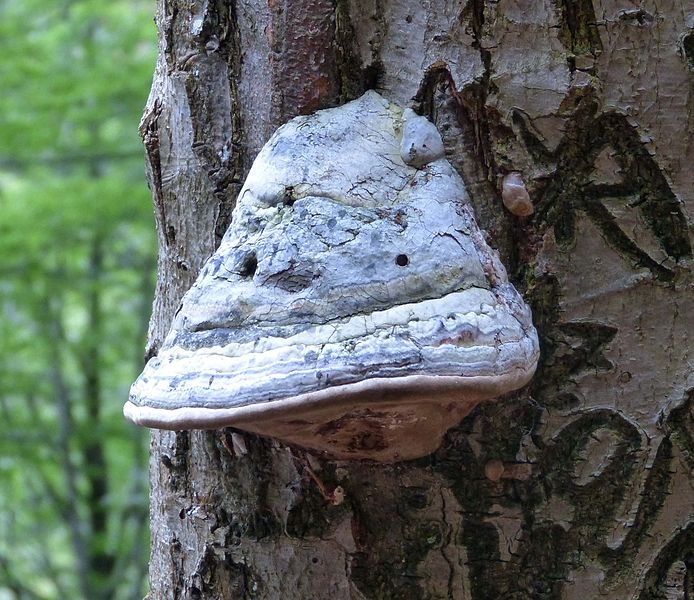This is the sixth part of a series on spring tree diseases. This article examines holly leaf spot, and hoof fungus.
Introduction
In spring, as the growing season commences, trees become vulnerable to infection from a bevy of diseases. While some of these diseases are relatively benign, many of them can cripple their hosts. The following describes some of the most common diseases to afflict plants in spring, and how they impact their hosts.
Holly Leaf Spot
Holly leaf spot, also referred to as holly tar spot, is a fungal disease that affects holly plants. The disease is likely caused by several fungi, including Phacidium curtisii, Rhytisma curtisii, Coniothyrium ilicinum, Marcpderma curtisii, and Phytophthora ilicis. Infections occur on older leaves during winter and spring. Infected leaves will appear abnormally spotted. Severe infections often result in extensive defoliation of the host plant.
Hosts
Leaf spot diseases are most common on American holly, and holly bush. They may also be observed on other species of Ilex.
Symptoms of Infection
Symptoms of holly leaf spot are easily distinguished. Most species of holly will develop tiny yellow spots on the leaves in spring. During summer, the spots gradually enlarge, turning reddish-brown. They develop into the characteristic black tar spot by early fall. Severely infected leaves drop prematurely. Defoliation generally occurs from the bottom of the plant, progressing upwards.
Treatment
- Plant holly bushes in conditions suitable for the holly type.
- Maintain plant vigor through sound cultural practices. Ensure that holly plants are sufficiently watered, especially during extended periods of drought. Apply a layer of organic mulch around the base of holly plants to improve soil quality, moderate soil temperature, and retain soil moisture.
- Routinely prune holly plants to promote sunlight penetration, and air circulation.
- Avoid watering holly bushes in the morning, or at night. Minimize leaf exposure to irrigation before midday. This will enable the leaves to dry rapidly during the afternoon.
- Fungicide applications on the shoots and leaves of holly plants will mitigate the effects of holly leaf spot. Initial applications should be performed in spring, just as the buds begin to swell. Two or three subsequent applications should be made during summer.
- Once the leaves fall, the disease cannot be treated. While this will temporarily reduce the ornamental value of the plant, the damage seldom lingers. In most instances, the host will survive, and produce a healthy flush of growth.
- Rake and dispose of any infected leaves. This will reduce the amount of inoculum available to initiate new infections. Avoid composting infected leaves; while composting will destroy most fungi, some may survive.
- Prune and dispose of infected leaves from holly plants. Disinfect pruning tools between each cut using a solution comprised of one part bleach and nine parts water.
Hoof Fungus (Fomes fomentarius)
Fomes fomentarius, also referred to as hoof fungus, tinder fungus, horsehoof tinder fungus, horse fungus, false tinder fungus, tinder conk, tinder polypore, and ice man fungus, is a fungal pathogen that infects various tree species. Hoof fungus produces distinct fruiting bodies that are generally shaped like a horse’s hoof. The pathogen infects susceptible trees through branch or bark wounds. Once established, the fungus causes a stem rot, which typically culminates in the death of the host. After the host has expired, the pathogen becomes a saprotroph, decaying the rest of the organic matter.
Hosts
Hoof fungus infects numerous trees. In the northern part of its range, its primary host is birch. In the southern part of its range, hoof fungus favors beech trees, particularly those that are suffering from beech bark disease. Oak, maple, cherry, hickory, lime tree, poplar, willow, alder, hornbeam, sycamore, and select conifers are also infected, albeit with less frequency.
Symptoms of Infection
Infected wood will become discolored, turning light brown to grey. As the decay advances, the wood softens, and brightens to a pale yellow-brown. When conditions are dry, the spores may be observed as a white powder on different surfaces. Small radial cracks, which are filled with yellow mycelium, may form on infected bark, lending the decayed wood a mottled appearance.
Uses
The flesh of the fruiting bodies is the main ingredient of amadou. Amadou is a material that is used primarily as tinder. To create amadou, the fungal bodies are collected from infected trees, and the rough outer layer is scraped off, revealing the spongy inner flesh. The flesh is then soaked in water. Once removed from the water, the flesh is cut into strips, which are subsequently beaten, stretched, and separated into fibers. Amadou was an important resource for many ancient civilizations. This was affirmed in 1991 when the 5,000 year old remains of Ötzi the Iceman were discovered on the Ötzal Alps. Ötzi had several amadou in his possession prior to his death, which it has been concluded he intended to use as tinder.
Amadou has been used as a material to craft items as varied as hats, gloves, pants, picture frames, and ornaments. Surgeons have used amadou as a styptic. Dentists historically applied amadou to dry teeth. Amadou is water absorbent, making it an ideal for use in fly fishing. The amadou is wrapped around wet flies, which enables them to dry out. In Siberia, amadou is mixed with tobacco, and sniffed. Entomologists use amadou to mount insects. In China, amadou is used to treat uterine, stomach, and throat cancer.
Treatment
- Avoid mechanical injuries to potential hosts.
- Maintain trees through sound cultural practices. Ensures that trees are sufficiently watered. Each year, apply fresh organic mulch around the base of trees to improve the soil quality, moderate the soil temperature, and retain soil moisture.
- Prune broken or damaged branches.
- Culling infected trees may prevent the fungus from spreading, and achieve some control.
Photo coutesy of Gail Hampshire CC-by-2.0


